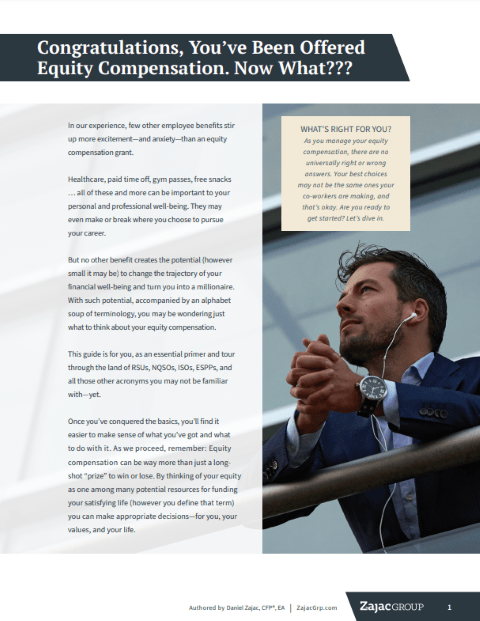An employee stock purchase plan is a company-sponsored benefit that gives employees a convenient way to purchase company stock.
Typically funded through payroll deductions, an ESPP can be a great way to participate in the success of the business you work for; if the company does well and the stock price increases, employees who participate may reap the benefit of owning shares that appreciate in value.
Of course, there’s a flipside to that. Owning company stock comes with the risk of loss should the share price fall below the price you paid to acquire it.
But after understanding the risks, you may still want to participate in an ESPP, because they’re not just convenient — they may actually provide some unique short-term protection against the risk of loss during periods of market volatility as compared to alternatives like the outright purchase of company stock or other forms of equity compensation.
To understand why, it makes sense to consider how an ESPP works, particularly features that your plan may include such as a lookback provision and a discount to the purchase price.
A Simple Illustration of How an Employee Stock Purchase Plan Works
As always, you want to check your ESPP document to see exactly how your ESPP works — but in general, most plans are very simple in concept. You enroll in the plan offered by your company, you contribute via payroll deductions, and shares of stock are purchased on your behalf.
GET THIS GUIDE
When it comes to your finances, it's important to understand what you have, what you should consider, and how it can impact your personal goals. This guide is the best place to start.
If you participate in an employee stock purchase plan, you likely contribute cash into the plan for a specific period of time. This is known as an offering period.
An offering period begins with an offering date and ends with a purchase date. The time between the offering date and the purchase date is referred to as the purchase period, which is often 6 months. For some plans, the offering period can last as long as 27 months and include multiple purchase periods.
During the purchase period, you contribute payroll deductions to your ESPP. As you contribute to the plan, you’re not actually purchasing shares; your money is held in escrow for the duration of the purchase period.
On the purchase date, your contributions are used to purchase shares on your behalf as a participant of the ESPP.
How an Employee Stock Purchase Plan May Offer Downside Protection
On the purchase date of the ESPP, contributions collected during the purchase period are used to buy shares of stock for the plan participants. If you contributed to the ESPP, then your stock shares are deposited into a brokerage account for you.
During the purchase period, the price of the stock price will likely move. It can be up or down, subject to typical market volatility.
If the stock price is up, the ESPP will purchase shares for the plan at a higher price than had you otherwise not participated in the plan and purchased shares on the open market on Day 1.
If the price is down during the purchase period, shares purchased in the ESPP will have benefited from contributions being held in escrow, allowing the purchase of shares to occur at the now-lower purchase date price.
This is a simplified scenario, but it illustrates how an ESPP can offer downside protection on the purchase price during the purchase period. During a period of volatility, particularly when markets lose value, the ESPP purchase process may be seen as an attractive benefit to limit the risk of loss.
Using an Employee Stock Purchase Plan with a Lookback Provision During Times of Market Volatility
A lookback provision is a benefit offered by some employee stock purchase plans. This allows for the purchase of company stock at the offer date price of the ESPP or the purchase date price — whichever is better (in this case, whichever is the lower cost). This can add to the ability to protect against downside risk during periods of market volatility.
Let’s assume that you enroll in an employee stock purchase plan. The company stock’s share price is $20 on the offering date — but the value rises over time and on the purchase date, the price is $50 per share.
A lookback provision allows for the purchase of shares at the better price. In this hypothetical, the ESPP participants benefit from the plan because their shares are being purchased at $20 each even though the stock is worth $50 per share.
Obviously, this is a great deal as you could immediately lock in a gain if you took your shares and sold them on the open market.
If the stock price is down during the purchase period and on the purchase date the stock price is $5 per share, shares will be purchased at the better purchase date price of $5 per share.
This lower purchase date price might provide additional benefit moving forward. As we mentioned, it’s possible that an ESPP can have an offering period, with a lookback provision, for up to 27 months. In this example, it would be possible to buy the stock at the original offer date price of $20 per share.
Some plans, however, may sweeten the deal and offer multiple offering periods at the same time, resulting in offering periods that overlap. If you have multiple offering periods at the same time, you’ll also have multiple offer dates price. If the volatile markets lead to a lower offering date price than your existing one, it may mean that you can lock in that lower offer date price on future contributions.
For example, let’s assume that following the original offering period and purchase date, the ESPP purchased stock at $5 per share. If the plan includes multiple offering periods, it’s possible that the current $5 per share price may actually occur at the beginning of a new offering period too, with a new offer date price.
If so, “switching” to a new offering period with a lookback price of $5 is certainly more advantageous than one with an offer date price of $20. As this example illustrates, an ESPP with a lookback provision allows a participant to benefit from upside volatility and may offer added benefits on downside volatility.
How the Added Benefit of an Employee Stock Purchase Plan Discount Can Fit into the Plan
Some companies will even offer a discount to the purchase price of company stock acquired through ESPPs. Discounts are usually set between 1-15% of the purchase price. This even more protection against market volatility, as the discount is directly from the actual purchase price of the stock.
If we assume a 15% discount and continue our lookback examples above, we can assume the following:
| Offer Date Price | Purchase Date Price | Purchase Price | Discount | Actual Price Paid | |
| No Lookback | $20 | $50 | $50 | $7.50 | $42.50 |
| No Lookback | $20 | $5 | $5 | $0.75 | $4.25 |
| Lookback Up | $20 | $50 | $20 | $3 | $17 |
| Lookback Down | $20 | $5 | $5 | $0.75 | $4.25 |
In all scenarios, the discount offers an additional reason to participate in an ESPP even if the stock price is down.
Employee Stock Purchase Plans During Market Volatility
It’s important to note that while a good ESPP may offer some purchase period protection on downside volatility of a stock price, that shares you own outright are not afforded this same luxury. Shares owned outright, possibly from an earlier purchase of ESPP shares, are subject to the full market volatility.
This means that good financial planning might be required to determine if you should participate in your company offered ESPP, how actively you should participate, and what if anything you should do once your shares are purchased.












0 Comments